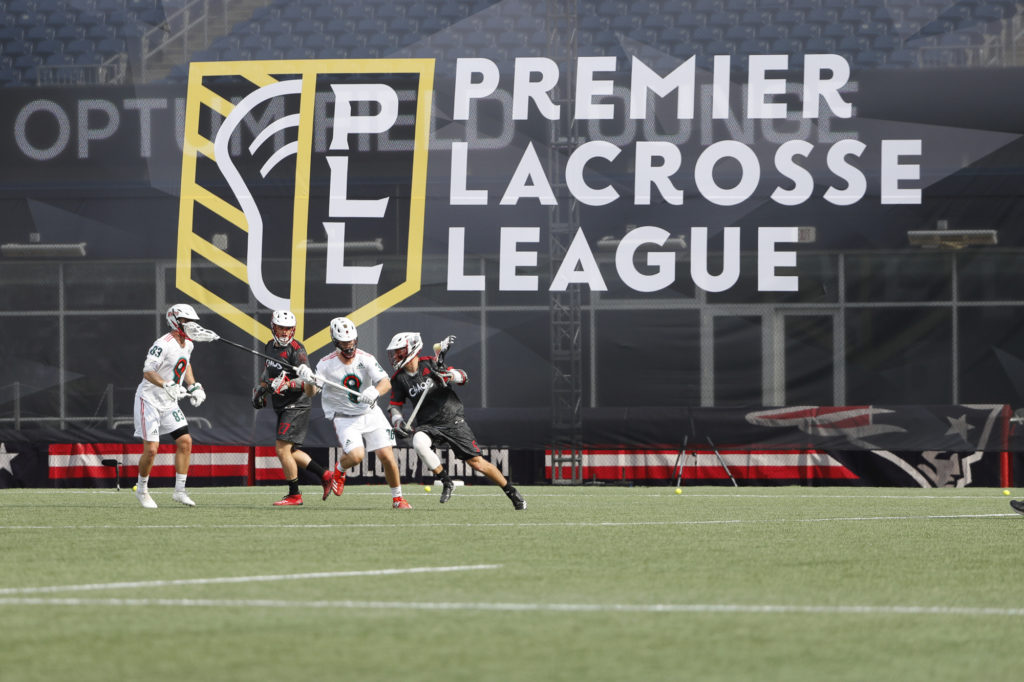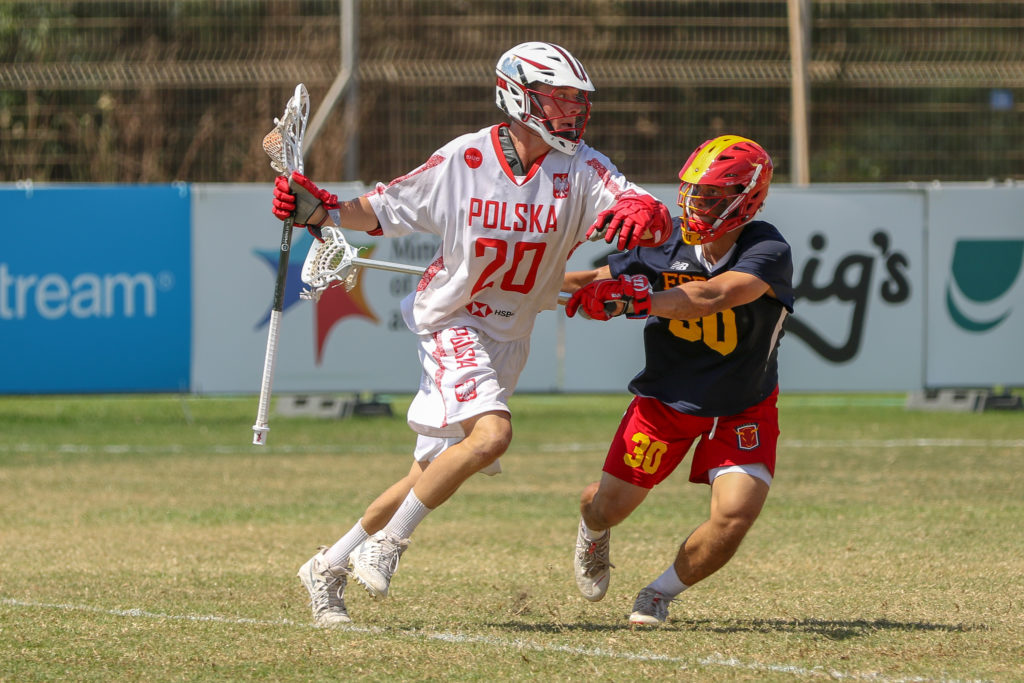
Lacrosse is one of the fastest-growing sports in the United States, and it’s making gains internationally as well. On the global front, lacrosse has grown to 62 nations fielding programs in 2018, up from the 18 that participated in 2002, according to Jim Scherr, CEO of World Lacrosse. And it’s been one of the fastest-growing sports in North America over roughly the past 20 years as well, he said. Scherr attributes the growth to the appeal of the game itself, as well as passionate supporters who have helped spread love of the sport throughout the United States and the world.
Several recent developments show the growing popularity of lacrosse as both a participatory and a spectator sport. Billed as the “most widely viewable lacrosse event ever,” the Men’s Lacrosse World Championship, held last summer in Netanya, Israel, showcased 46 teams, with more than 300 hours of play televised in almost 50 countries, according to the federation.
Lacrosse is making a splash in several other ways as well. A new professional league has begun play, the International Olympic Committee issued provisional approval to World Lacrosse, and U.S. Lacrosse has announced it will “make every effort” to make the game more inclusive by ensuring that Native American mascots or logos will not be used at events the organization controls.
Sponsored Content
1. Upstart New Professional League
While the National Lacrosse League still has a monopoly on the professional indoor version of the game, Major League Lacrosse now faces stiff competition in the outdoor sport, with a new league about to turn pro lacrosse on its head. Launched in October 2018, the Premier Lacrosse League is the brainchild of lacrosse star Paul Rabil and his brother, entrepreneur Mike Rabil. “Frankly, we’ve been in a position where we have felt stagnant as a sport for a long time, given the ongoing growth at the youth level, high school, college and even internationally,” said Paul Rabil, the league’s chief strategy officer. “We put our heads together about what the game could look like from a business standpoint all the way through distribution, essentially pressed reset, and built from scratch.”
The league, which debuted June 1, is based on a touring model similar to NASCAR and WWE, he said. Six teams of 20 players each will play a 14-weekend season. NBC Sports Group owns exclusive media rights for the games across broadcast, cable, digital and consumer platforms. The regular season will have 10 regular-season games, followed by playoffs culminating in a championship on September 21. Twelve cities will host games.

PLL adopted a touring model after deciding that “lacrosse isn’t like the NFL or Major League Baseball,” with city-specific teams dispersed throughout the country, Paul Rabil said. Playing in different cities will enable fans all over the country to attend a game and give players the unique opportunity to play “at premium venues,” he said. Tour-based play also permits flexibility in network media coverage.
The Rabils have found investors receptive to their plan for a new league. Both men first approached Major League Lacrosse with their idea to rework the current structure of professional lacrosse. “When that ran into a dead end, we shifted our approach from a private-equity-backed to a venture-capital-backed one,” he said. Investors include Alibaba Group Holding and Hildene Capital Management. Many of the investors have pro sports and media experience.
Teams were assembled based on players’ college connections, former pro team chemistry, skill and age, Paul Rabil said. The game will feature the usual 10-on-10 action, with the same pace of play of other leagues. Players will have an equity stake in the PLL, giving them the opportunity to benefit from the league’s long-term success.
The impact of the PLL is already being felt. In April Major League Lacrosse, which has lost several players to the new league, announced that three of its teams would not play the 2019 season, leaving the league with six remaining franchises. One of the disbanded teams, North Carolina’s Charlotte Hounds, is expected to return in 2021 after stadium renovations.
2. A Door Opens to the Olympics
Meanwhile, lacrosse is gaining ground on the Olympic stage. The executive board of the International Olympic Committee extended provisional recognition to World Lacrosse—which recently rebranded from the Federation of International Lacrosse—in November 2018. The announcement was “a huge, meaningful day for the sport,” said Scherr, the federation’s CEO and the former CEO of the U.S. Olympic Committee, because it represents the first step toward possible inclusion in the Olympic Games.
The IOC decision makes World Lacrosse part of the Olympic family. “I think the lacrosse family always felt like it was something that would happen,” Scherr said, adding that the IOC is in the process of determining how many sports it wants to provisionally recognize, what that process looks like, and how to do it. World Lacrosse, which was formed in 2008 and has 62 member countries, was worried that IOC approval might get caught up in timing issues that could slow down or halt the acceptance process.

Provisional recognition starts a three-year period in which the IOC monitors World Lacrosse to see whether it continues to progress as the sport’s international governing body, Scherr said. Eventually, the IOC staff could recommend World Lacrosse to its executive board and then to the total IOC membership, which would then decide whether to grant full recognition, he said.
Scherr said World Lacrosse is “very much looking forward to being included in upcoming Games.” The 2028 Summer Games in Los Angeles may be a perfect fit, he said. “It’s incredibly significant that the IOC recognized lacrosse as a growing sport and a legitimate force on the world stage,” Scherr said.
3. Increased Cultural Sensitivity
U.S. Lacrosse, the national governing body, is guiding the growth of the sport and navigating through several sensitive issues. In particular, U.S. Lacrosse has established a Native American Advisory Council to address how the sport handles issues surrounding the treatment of Native Americans. The advisory body chose to focus first on mascots, said Steve Stenersen, president and CEO, and as a result, U.S. Lacrosse has decided it will not promote or use Native American mascots or logos at its lacrosse events.
“There are some issues that occurred in our sport, which sadly are a broader part of our culture, that we felt it was time for us to address,” said Stenersen, who noted that the issue is especially important given that the sport of lacrosse is rooted in Native American culture.
In March, U.S. Lacrosse launched a Cultural Competency Course as part of its broader effort to foster inclusion and diversity in the sport. The free online course intends to make lacrosse a more accessible and tolerant sport. The course has four main modules: implicit bias, microaggression, social class and building inclusive teams and leadership.
U.S. Lacrosse also has given millions in grants to support the growth of the sport. “We have earmarked a number of those resources each year to underserved communities,” Stenersen said. “Of course, Native American communities are sadly underserved and are quite frankly overdue to get some help from people who support our mission.”
The new cultural competency curriculum will provide more comprehensive resources to the national lacrosse community, including teaching every coach about the sport’s roots in the culture of America’s indigenous peoples.
“Sadly, lacrosse is no different than the rest of society today,” Stenersen said. “There are cultural issues that we think sports should be free from. We think sports should be for every child regardless of ZIP code or cultural heritage. There has certainly been some feedback over the various media channels, social media and otherwise, that such discussions should not occur in sports.”
But a diverse experience that allows a child to play with a teammate from a different background “is in fact a better experience,” Stenersen said. Although there’s been some pushback, the response to the focus on mascots and images has been overwhelmingly positive. “It’s caused many to stop and pause,” he said, “and reflect on the sport’s Native American heritage.”












 Copyright © 2025 by Northstar Travel Media LLC. All Rights Reserved. 301 Route 17 N, Suite 1150, Rutherford, NJ 07070 USA | Telephone: (201) 902-2000
Copyright © 2025 by Northstar Travel Media LLC. All Rights Reserved. 301 Route 17 N, Suite 1150, Rutherford, NJ 07070 USA | Telephone: (201) 902-2000